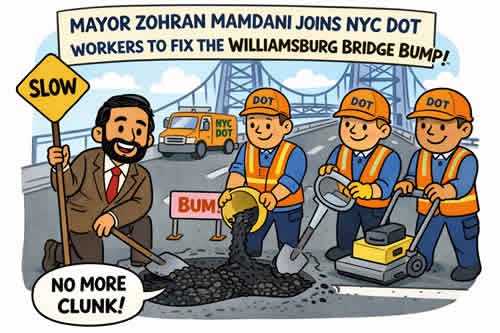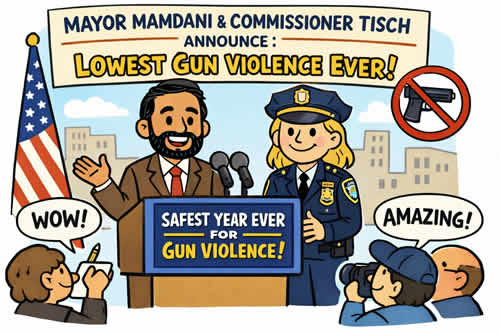New York City Mayor Eric Adams opened the first-ever National Urban Rat Summit, emphasizing the importance of rodent control for improving the quality of life in the city. The summit brings together experts to share strategies on combating rat infestations, with a focus on scientific methods and community involvement. Mayor Adams highlighted the city’s commitment to reducing rodent activity through containerized garbage solutions and collaborative public health efforts.
Transcript: Mayor Adams Delivers Opening Remarks at National Urban Rat Summit
Kathleen Corradi, Citywide Director of Rodent Mitigation: All right, so welcome once again to the National Urban Rat Summit hosted in New York City. My name’s Kathy Corradi, citywide director of Rodent Mitigation. And I am delighted to start our summit with a welcome from the 110th mayor of New York City, a big advocate in this work, Mayor Eric Adams. Good morning, mayor. Welcome.
Mayor Eric Adams: Thank you. Wow, I didn’t realize we were going to get so many people showing up to talk about rats. But we sometimes make light of the conversation as part of various ways we let go of the stress. But our director of Rodent Mitigation, Kathy, really understood how important this issue is.
If you just think about it, those who are used to any form of pests, my family, we had a farm in Alabama. So we always had something scurrying around. But rats impact the quality of life more than we realize. As a police officer in this city, I remember we used to tell people the tips of not going out at night, be careful what you do, and public safety tips.
As I move throughout the city and hear families talk about how they alter their behavior, how they refuse to go out during the dark, how traumatizing it is, and you could only imagine lifting up your toilet seat in the morning and seeing a rodent come out. Or your garbage bag, you take the garbage and put it outside, and you see a rat run across your feet. You think about that all day. You will never walk again near that garbage pail without thinking about it. And you will never even want to go into your restroom. You’ll never feel comfortable again in that bathroom or in your kitchen.
There are stories I hear from residents who talk about there are parts of their house that they won’t enter. They won’t go inside. And it’s just so traumatizing of that experience. And that’s why we became extremely serious about rodent mitigation. Because it was not just this passing conversation. People used to come to us shaking, and tears in their eyes. Their homes were being hijacked, that they no longer could enjoy the quality of life that they deserve. And I’m just a real believer that if you have one space that you should feel extremely comfortable in, that’s your home.
And that’s what this is about, the cross-pollination of ideas from across the country to state. How do we deal with a problem that has always been here? Rodents have always been here from the beginning of times. I don’t know if it’s the Pied Piper or all the stories we heard. But how do we really have a real approach of using scientific methods, using what you’re doing in your cities or across the entire country, if not the globe? I was speaking to the mayor of Paris where they just use their sewer system and just put the garbage down there.
So there are different methodologies to address a real quality of life issue. And that is what our director has been doing. We call her the rat czar because of the work that she has been doing. And combining with our Department of Sanitation, where we realized from our analysis that one of the major problems is the all-you-can-eat buffets that we have in our plastic bags. When I go to European cities and we say we have plastic bags, they say, plastic bags? You have plastic bags on your streets? Everyone is containerizing their garbage. And we’re seeing a decrease in rat sightings because of the containerization of garbage. And I don’t know who was the character that made up these mint plastic bags. Those rats laugh at those mint plastic bags.
So that’s what this is about. And that’s what our pursuit is. And I see we have Dr. Vasan here, our commissioner of the Department of Health and Mental Hygiene, because it impacts both. It impacts the health, the diseases, less carry. I remember as borough president, a group of mothers came to me showing me photos of rats that would get into the cribs of their babies and eat the food on their faces. So it impacts the health. And it also impacts our mental stability.
I don’t think there’s been a mayor in history that says how much he hates rats. I dislike rats. And I am so happy I have a four-star general who is working on finally winning the war on rats. We will make an impact. And if we do so, we’re going to improve the health and the mental stability of everyday people in this city.
Thank you for being here. Let’s be energetic. Let’s share our ideas. Let’s figure out how we unify against what I consider to be public enemy number one, Mickey and his crew. Thank you so much.
Corradi: Thank you, Mayor Adams. We are certainly in a unique position to have a mayor so committed to this goal. So again, I want to welcome everyone to the inaugural National Urban Rat Summit. I’m honored and humbled to stand in front of this remarkable group and open up two full days of content and collaboration.
Under Mayor Adams, New York City has a clear mission, build a safer, more affordable city with better, cleaner public spaces for all. And that’s exactly what we’re doing here. We’re here standing on the shoulders of giants, many of whom are in this room now, taking a bold step forward in advancing the understanding of municipal rat management with a collective commitment to lead with science and put research into action.
We are on the precipice of a remarkable period in the world of urban rats, a period where political, scientific, public health, municipal, and public interests are activated and aligned, a period where the research that highlights the complexity of urban rat management is considered in municipal solutions and scale is viewed as an asset, not an afterthought, a period where fascination and fear will be cultivated into empowerment and action.
These next 48 hours are part of a much larger dialogue, a centuries-long conversation between humans, their urban spaces, and the rats who have eagerly exploited them both. It is through understanding this history that we can join confidently in community to look forward to a new paradigm in urban rat management, a future where all, academics and advocates, cities and citizens, are working in partnership to achieve our common goal.
I want to thank all of you for taking the time to come together with us and move this field forward. Now I have the distinct honor of welcoming the commissioner of the Department of Health and Mental Hygiene, Dr. Vasan. Thank you.
Commissioner Ashwin Vasan, Department of Health and Mental Hygiene: Hello, everyone. Good day. I’m Ashwin Vasan. I’m the New York City Health commissioner. It’s great to be here today.
I can’t say this was my dream when I went to medical school to think about rats, but it has become a real passion for my team, for my department. And we’re so glad to be working with all of our city agencies on this today. It’s an opportunity to celebrate this work and to learn. And it’s work that is deeply core to public health.
Since the 14th century, when fleas traveling on rats were linked to the Black Death, rat control, the control of rats, has been inextricably linked to the control of infectious diseases and, of course, to public health. Thankfully, those days are long behind us, although lots of work on zoonoses these days. But rat control is no less important, not just to disease prevention. It’s also about a sense of freedom, freedom from stress, from fear, and from the feeling that the place you live is in some state of disrepair or disregard.
Yes, this work is core to public health and it’s core to public policy here in New York City and throughout our rapidly urbanizing world. By 2050, it’s estimated that 70 percent of the world’s population will live in cities. In the industrialized world, that could reach up to 90 percent. So the way in which we control rat populations, especially in older cities with aging infrastructure, will continue to be important to public policy, frankly, to global public policy, to global public health.
Not because rats, day on day, represent a clear and present danger to human health, although the mayor is correct, the sense of safety and mental health and stress is real. But also because failure to manage the problem contributes to a sense of unease at an already uneasy time. It contributes to a sense of mistrust at an already historically mistrustful time and divided time. And controlling our rat population builds confidence, confidence in our leadership, confidence in our institutions, confidence in each other that our city, our cities, our country, our nation, and our world is headed in the right direction, whatever the turmoil that might appear.
That’s why I’m so grateful for this work, especially that of my colleagues in the New York City Health Department. No shade on anyone else, the best health department in the world, sorry, guys, who bring scientific rigor and stubborn commitment to our efforts to end the reign of rats in our city.
Pest control is also a core issue of health equity. The burden of rat infestation in New York City neighborhoods is not equally distributed. That’s why we work hard to target our efforts to where they’re most needed. And often, that means in communities that have been historically neglected or disinvested in. Those targeted efforts are rooted in data and in evidence to help us determine what our priorities are and the most effective methods to stop rats and to interrupt their life cycle.
We’ve invested in a comprehensive integrated pest management strategy that emphasizes inspections, monitoring, and removal of the conditions, including trash, that rats need in order to survive in New York City. This holistic strategy includes rat indexing, a process that allows us to identify and address all of the properties in a particular neighborhood with high rat activity and to ameliorate those conditions together, simultaneously.
Engaging the public via our rat information portal, featuring current rat inspection results and follow-up actions. Targeting rat mitigation zones. These are areas with extremely high burden of rat activity, where we focus on coordinated multi-agency effort to address rats and, of course, the conditions in which they thrive. And perhaps our most important strategy of all, robust community engagement. That involves everyday New Yorkers. That empowers everyday New Yorkers with best practices for controlling rats in and around the places they live.
Our health department’s nationally acclaimed Rat Academy provides free training for community members in how to keep rats out of their homes, businesses, and neighborhoods. This year alone, we’ve had about 800 participants. And since it started in 2019, we’ve had 6,000 New Yorkers participate in our training and to take that back to their communities to make a difference.
Of course, the challenge is enormous. As my scientists always say, I see Bobby there, we will never get rid of rats altogether, particularly in a city as old with infrastructure like New York. It’s not about eliminating rats to zero, as much as that’s a laudable goal. It just doesn’t work with the kind of aging infrastructure, sewer systems, and environment density of living that we have in a place like New York City. But we can keep them out of our everyday lives. And people from all walks of life coming together to make sure they live in a city that’s cleaner, safer, and more livable is part, the core pillar of that strategy. Their commitment and hard work make all the difference for fellow New Yorkers.
But this is not a problem, of course, that will be solved overnight. So the more that we collect research and best practices, the more that we share those findings with each other. And I’m so glad to be here today, because we get to not only share our work, but to learn from all of you, the better we’ll all be as we tackle this interesting intersection of public health, safety, well-being, and frankly, just community standards. How do we want to live? What kind of cities and what kind of places do we want to live in? And what are we willing to do about it?
I want to thank you all for coming all this way to New York City. We’re eager to learn from you. We’re eager to share our work. And mostly, we’re eager to put rat control on the agenda, on the municipal agenda, which is truly the national and global agenda. So thank you so much. I’m looking forward to a debrief on the whole day. Unfortunately, I can’t be with you. But really exciting. And thank you to Kathy for your leadership.
Corradi: Thank you, Dr. Vasan. Our Health Department is peerless in many ways. And we’re grateful for your leadership. I want to now invite up Dr. Matt Frye from New York State Integrated Pest Management Program at Cornell. Not only is he a leader in this field, but he was part of the conference committee who helped this come to action. So thank you, Matt.
Matt Frye, New York State Integrated Pest Management: Thank you, Kathy and good morning, everyone. I’m really excited to be here today with all of you. This is a wonderful opportunity for us to be together and discuss a topic that is near and dear to so many of us that we rarely get the opportunity to spend two full days discussing rats.
So at the New York State IPM program, as part of Cornell University, we’re really appreciative of the efforts of the mayor’s office and the Department of Health and Mental Hygiene for their continued efforts to address rat issues and for their collaboration on this project.
So for my comments today, in terms of an introduction, I wanted to say that this is awesome, right? Getting all of these people together in the same room, we have the preeminent scientists that are studying urban rats throughout the country and the world. We have municipalities from primarily the states, but all over the world as well, bringing their expertise. And representatives from state and federal agency. And we’re all here to talk about rats. So we’re very happy that everyone is here.
The only thing that I wanted to do is just sort of summarize what we’ll be hearing about today and put into context the topics. Because we’re going to start from the beginning and talk about how we got to this problem. What is the issue with rats? Why do we deal with rats in cities? What are the problems that extend beyond just gnawing damage and resident complaints extending into public health issues?
We’ll take a look at why the war on rats mentality may not be the best approach for our urban areas, and how we can use science to inform and implement better management strategies. So with that brief introduction, I want to welcome you all. I hope that everybody takes the opportunity to engage, to learn, and to participate, and just have a blast the next couple of days. So thank you so much.
Corradi: Thank you, Matt. Again, thanks everyone for being here. That’s the end of our opening remarks.
September 18, 2024 New York City Hall
Sources: Midtown Tribune news, NYC.gov
Big New York news BigNY.com










